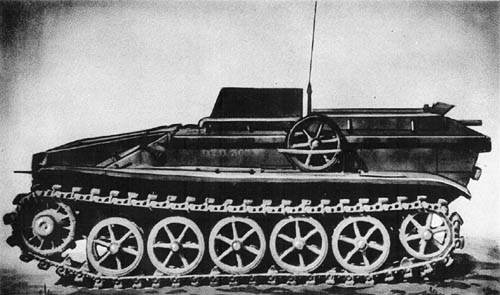
This vehicle is designed to convey a heavy demolition charge to a selected tactical objective, at which point the load may be dropped, the vehicle retracted, and the charge detonated. While it may be driven near the target, its special feature is the remote radio-control with which it may be operated after the driver leaves. Its chief use is to demolish pillboxes and strongpoints.
The hull, which is of one piece welded construction, is divided into three compartments. The engine, radio equipment, and hydraulic mechanism are contained in the rear compartment, the transmission units in one of the forward compartments, and the driver’s controls and instruments in the other. Three overlapping flaps of
The vehicle is powered by a 6-cylinder, inline, water-cooled, gasoline engine, similar to commercial types. It develops approximately 80 horsepower and is supplied by two fuel tanks with a combined capacity of 28.6 gallons.
From the engine, the drive is taken forward through a fluid coupling to the gear box. Two speeds forward and two speeds reverse are provided by high and low range gears. Power is transmitted to the forward sprockets through a train of four spur gears. Suspension is on torsion bars. There are five double rubber-tired bogie wheels on each side. The cast steel center guide tracks have detachable rubber pads and are
An 800-pound explosive charge is carried in a container on the sloping front. Drop arms hinged to the sides of the front permit the warhead to be lowered to the ground, jettisoned, and the vehicle withdrawn from the destructive arc before the charge is detonated by means of a time fuze or electric detonator.
Radio control of the vehicle is effected by transmitting a carrier of frequency between
SPECIFICATIONS
| Weight | 4 tons | |
| Length | 12 ft. | |
| Width | 6 ft. | |
| Height (including driver’s shield) | 4 ft., 7 ins. | |
| Ground clearance | 12 ins. | |
| Tread centers | 5 ft., 2 ins. | |
| Ground contact | 5 ft. 10.5 ins. | |
| Width of track | 7.75 ins. | |
| Track links | 50 | |
| Pitch of track | 5.5 ins. | |
| Armor | ||
| Front plate | 10 mm | |
| Sides | 13 mm (5 mm + 8 mm) | |
| Armament | 800-lb. explosive charge | |
| Engine | 6-cylinder, O.H.V. gasoline, 80 horsepower. | |
| Transmission | 1 fwd, 1 reverse with high and low range—hydraulic clutch. | |
| Steering | Epicyclic steering brakes either manually or hydraulically controlled. | |
| Crew | 1 | |
| RADIO EQUIPMENT | ||
| Type receiver | Superheterodyne | |
| Frequency | 24,600 kilocycles | |
| Local oscillator | Crystal controlled | |
| Intermediate frequency | 464 kilocycles | |
| Tubes | ||
| Receiver | 1 ECH 11 Mixer-Oscillator | |
| 1 EF 13 Fixed i-f amplifier | ||
| 1 EBF 11 second i-f AVC, Second detector | ||
| 2 EF 12 Audio amplifiers | ||
| Filter unit | 5 EF 12 Relay control | |
| 1 EF 13 Relay control | ||
| Power supply | 12 v. storage battery with dynamotor | |
| Voltage | Plate—200 v. | |
| Filament—6 v. | ||
German: p. 40.2 (April 1, 1945)